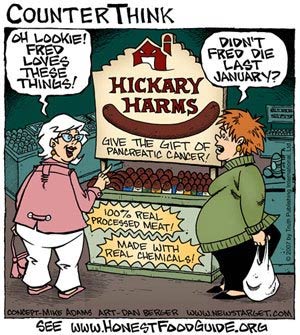Processed Meats Dangerous for Human Consumption
By Mike Adams | Jul 01, 2008

Have you ever wondered why the consumption of processed meats is so strongly linked to cancers of the colon, breast, prostate and pancreas? The evidence continues to mount, as demonstrated by a recent study showing a 67% increase in pancreatic cancer for people consuming moderate amounts of processed meat on a frequent basis.
Conventional medical doctors and nutrition researchers tend to put the bulk of the blame on the saturated fat content of processed meats, but that ignores two notable culprits that I think are far worse offenders when it comes to human health. Let’s take a closer look at these two problems with processed meats.
The first problem is found in the fats of these processed meats. The problem isn’t the fat molecules themselves, but rather the toxic chemicals, heavy metals and environmental pollutants that are found inside those fat molecules.
You see, fat tissues — whether in a cow or a human — tend to concentrate whatever pollutants are found in the mainstay diet of the animal. A cow eats literally tons of grass in its lifetime, and in doing so, it collects and concentrates low-level pollutants found in its diet. For non-organic beef, it’s quite common to find trace amounts of heavy metals (mercury, cadmium), pesticides, and even PCBs. That’s because, for non-organic beef, feed practices are rather horrifying. You’d be shocked to learn what’s perfectly legal to feed to cows intended for human consumption.
So while conventional doctors tend to put the health risk blame on the saturated fat found in meat products, I think it has a lot more to do with the toxic substances concentrated in those fat tissues. A cow is much like a land bottom-feeder, and eating meat from a non-organic cow is a lot like eating shrimp from the bottom of the ocean.
These toxins, when consumed, are clearly and unquestionably linked to cancers as well as nervous system disorders that can accelerate Alzheimer’s disease and dementia. They also stress the liver and impair immune system function. The human body should never be exposed to mercury, PCBs or the rocket fuel chemicals that are now almost universally found in cows’ milk products across the country (in a 2005 Texas Tech University study, perchlorate was detected in 46 of 47 store-bought samples of cows’ milk across 11 states).
The second (and more important) reason processed meats are so strongly correlated with cancer is, I believe, the continued use of a cancer-promoting additive called sodium nitrite.
This ingredient, which sounds harmless, is actually highly carcinogenic once it enters the human digestive system. There, it forms a variety of nitrosamine compounds that enter the bloodstream and wreak havoc with a number of internal organs: the liver and pancreas in particular. Sodium nitrite is widely regarded as a toxic ingredient, and the USDA actually tried to ban this additive in the 1970’s but was vetoed by food manufacturers who complained they had no alternative for preserving packaged meat products.
You can find sodium nitrite in nearly every packaged meat product imaginable. It’s listed right on the label of products like bacon, breakfast sausage, beef jerky, pepperoni, sandwich meat, ham, hot dogs, and even the meats found in canned soups. If you and I walked into any grocery store in America, I could show you hundreds of products that contain this ingredient right now. And I believe this sodium nitrite is the primary cause of pancreatic cancer in humans who consume even moderate quantities of processed meats.
If sodium nitrite is so dangerous, why does the food industry use it? Simple: this chemical just happens to turn meats bright red. It’s actually a color fixer, and it makes old, dead meats appear fresh and vibrant. Thus, food manufacturers insist on using sodium nitrite for the simple reason that it sells more meat products. Consumers are strongly influenced by the color of grocery products (which is why Florida oranges are often dipped in red dye, by the way), and when meat products look fresh, people will buy them, even if the true color of the months-old meat is putrid gray.
There is a way to minimize the damage from sodium nitrite, by the way. You won’t hear this from the USDA these days, since the department doesn’t really want to discuss sodium nitrite at all. Since the 1970’s, the USDA has shifted into protection mode of the very industries it was supposed to regulate… to the point where it now acts as more of a marketing branch of the beef, milk and grain industries.
The proven protection strategy is to consume fairly large doses of vitamins C and E before dietary exposure to sodium nitrite. This nutritional protection strategy inhibits the conversion of sodium nitrite to cancer-causing nitrosamines. Personally, I would never consume any processed meat products, but if you choose to do so, you can reduce your risk of cancer from sodium nitrite by consuming these antioxidants before your meal.
Consuming chlorella before or during meals with meat will also theoretically protect you from various environmental pollutants. Chlorella is well known to bind to heavy metals in particular, shepherding them out of your body before they can do much damage. Personally, I take chlorella any time I eat seafood for this very purpose.
You can also, of course, turn to fresh, organic, free-range meat. That’s the safest approach for any meat consumer. Yes, it’s expensive, but last time I checked, treating pancreatic cancer was a bit on the pricey side, too.
There are other problems with processed meats, nutritionally speaking. Meat has zero fiber, for one thing. But in terms of the major causative factors of disease in the human body, I believe the two primary culprits are the heavy metals and toxins concentrated in the fat tissues of cows, combined with the sodium nitrite additives used by meat processing companies to preserve their products and give them enhanced visual appeal.
And thus, the saturated fat argument is a distraction from the real causes of cancer that the U.S. beef industry doesn’t want to talk about. It’s not the saturated fat that causes pancreatic cancer. For example, coconut oil consumption wouldn’t cause a person’s risk of pancreatic cancer to leap 67%, although it’s still saturated fat. The real cause of the cancer, I believe, is what’s found INSIDE the fat, and what’s ADDED to the meat during processing and packaging.














